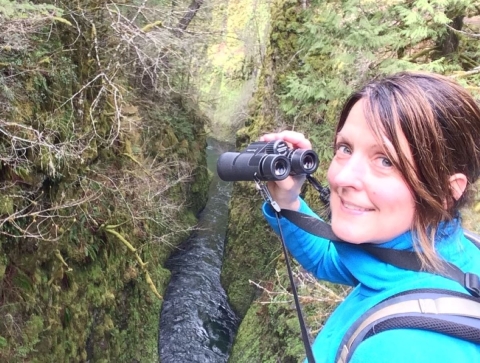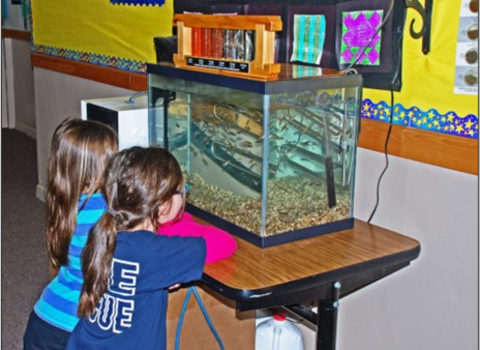Hey Roberta! Tell us about yourself.
Growing up, I just liked being outside, and this was encouraged by my mother who was an amateur naturalist. She often shared her tree fruit collection — a binder with pressed seeds and pods — and taught me to identify birds by sight and sound. We hiked and camped as a family, and I’m sure this is where my love of nature started. My mother was my hero for a lot of reasons, but I was also lucky enough to have several strong, smart female mentors who helped me navigate the world of professional biology. Outside of work, I enjoy making my own habitat safe, beautiful and attractive to wild birds by providing shelter and food through native plant landscaping and nest boxes. I also like sharing information about the importance for both birds and pets to keep cats indoors. Watching birds build and fledge from nests in our boxes and trees, and seeing hummingbirds drink from the plants I’ve provided, is a privilege and a thrill that I look forward to every spring.
What did you study or how did you get involved in public service?
My first degree was a bachelor’s degree in ecology from University of Virginia, which gave me a very wide-angle view of biology and conservation. I also earned a master’s degree in wildlife science from Oregon State University studying Hawaiian petrels at high elevations on Mauna Loa in Hawaii Volcanoes National Park. I’ve had many adventures working with plants and animals all over the United States, including small mammals such as squirrels and mice; pinnipeds; birds such as waterbirds, wading birds, waterfowl, shorebirds, and raptors; and different kinds of stream fish. I’ve worked in Alaska, Hawaii, Texas, Delaware, Oregon and many places in between. In the first decade of my career, I moved around a lot, applying for and accepting whatever job sounded interesting, trying to build my career experience. During my second decade, I focused on finding stable year-round employment and took a permanent job with the Navy. One thing led to another, and after a few years I landed at the U.S. Fish and Wildlife Service!
Can you tell us a little bit about your job?
I am currently the seabird coordinator for the Office of Migratory Birds in the Pacific Region. This position involves coordinating and communicating with internal and external partners about projects and actions that conserve seabirds and other migratory birds. These projects include research, monitoring, management, regulation and policy development, as well as permit reviews. The most surprising thing about my job is that after all that training in biology, I now work more with people than animals. But the biology degrees and experience still inform my work.
What’s your favorite thing about working for the Service?
My favorite thing about working for the Service is the smart, knowledgeable people I get to work with and the amazing places I get to occasionally visit. It feels great to be united on a single mission to conserve our nation’s fish and wildlife.
Which National Wildlife Refuge is your favorite? Definitely Midway Atoll National Wildlife Refuge! It’s part of Papahānaumokuākea Marine National Monument in the Pacific Ocean. It’s heaven on Earth if you love seabirds. Plus, the cook on Midway is from Thailand and makes the most amazing food!
What advice do you have for someone interested in a career in conservation or public service? Do what you love and be persistent. Have fun and enjoy what you are doing at the time, or you’ll look back later and wish you did! Don’t compare yourself to anyone else; we each have our own journey. Take advantage of your opportunities. Don’t be afraid to study a critter you aren’t particularly interested in on your way to working with your favorite bird. It’s all useful experience! You might have a certain image of where you will be in 10 years, but if you keep your mind open, you might end up somewhere unexpected but equally great!





